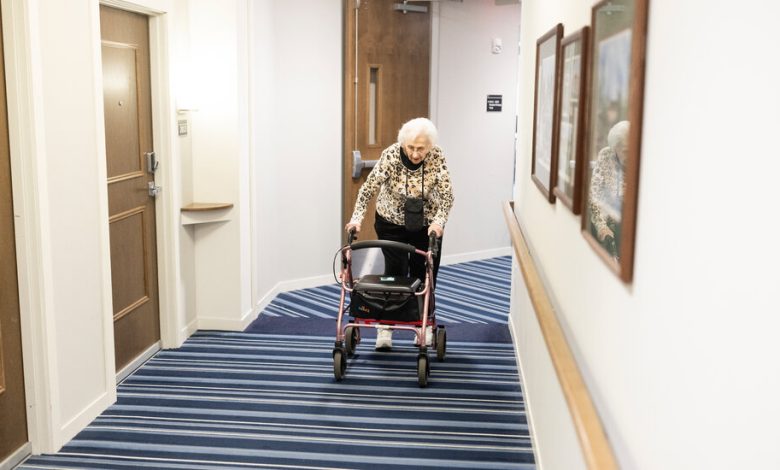What to Know About Assisted Living

Are you confused about what an assisted-living facility is, and how it differs from a nursing home? And what you can expect to pay? Here’s a guide to this type of housing for older people.
What is assisted living?
Assisted-living facilities occupy the middle ground of housing for people who can no longer live independently but don’t need the full-time medical supervision provided at a nursing home. They might be right for those who have trouble moving about, bathing, eating or dressing, or who have Alzheimer’s disease or other forms of dementia.
Assisted-living facilities can look like luxury apartments or modest group homes, but they are staffed with aides who can help residents take a shower, get out of bed, get to the dining room, take medications, or help with other daily tasks and needs. Meals, activities and housekeeping are usually provided. Some facilities have trained nurses on-site, but in many states the facilities are not required to have them at the ready, or at all. Popular buildings — or specialized units within them, such as ones for dementia — have waiting lists.
“The key is to start early,” said Eilon Caspi, an assistant research professor at the University of Connecticut. “You don’t want to wait for the crisis and then have 24 hours to make a decision.”
How can I know how much assisted living will cost me?
The monthly costs to live in a facility generally range from $3,000 to $12,000 or more. Charges are frequently broken into two components: rent and a care plan. Rents are set similarly to the way landlords establish them for apartments, with larger units in more expensive regions having higher rents and rent concessions more likely when many units are unoccupied.
The costs of care plans are based on how much assistance the facility thinks residents will need, at least when they first move in. Most of them assign residents a “level” or “tier” based on the extent of their needs, but some will itemize charges for specific services. It’s like the difference between a prix fixe and an à la carte menu (except you don’t get to choose which approach you prefer within each facility). Assisted-living units or facilities devoted to dementia residents are more likely to set one comprehensive price, though many have tiers.
Make sure the facility’s assessment reflects what the resident will need, or it might increase the price if it is providing more assistance than expected. Check if meals are priced separately.
What charges may catch me by surprise?
Facilities often have nonrecurring initial charges, like move-in fees or “community fees.” You should ask whether there are extra charges for things residents might need or use, like nurse visits, cable television or other kinds of assistance: Such charges can pile up quickly if they’re not detailed as included in the care plan. Some places even charge more if you get medications from a pharmacy other than the one they have a business relationship with.
It’s worth checking a few months after moving in to see if the care plan is more than the resident needs. If so, ask for the price to be lowered to remove services that aren’t being used.
Is it better to go with a facility that charges a set monthly amount or one that bills for each service?
If you want predictability in your monthly bill, you’re safer with a facility that is all-inclusive or that charges by tiers or bundled services. That’s also true if you need assistance with many things. If you don’t need a lot of help, à la carte may be better. Some facilities have an independent living wing or a program with à la carte pricing, which may be best for those who need only sporadic assistance. If you need more help as time goes on, you can transition to the assisted-living section or program and get a care bundle.
What happens when a resident ages and becomes frailer?
Care plans for those needing the most assistance can be double or triple the cost of those for the most independent residents. Ask the facility to explain what causes price increases. Be honest with yourself, and the facility, about what you can afford when the bill rises, because it’s going to. “You’ve got to understand your future is coming,” said Karen Van Dyke, a certified senior adviser in San Diego who helps families find the right facility for them.
Also make sure you understand the maximum level of care the place can provide. If you require more, the home may make you move out. For instance, some places will care for people who have occasional lapses of memory or disorientation but not those whose dementia causes delusions, agitation or aggression. There are fewer legal protections against evictions in assisted-living facilities than in nursing homes. Be realistic about what you need: No one wants to move into a nursing home, but it’s dangerous for residents to stay in an assisted-living facility that can’t take care of them.
What happens if I run out of money?
You may have to leave. Most assisted-living facilities are for-profit, and they have no legal obligation to keep the indigent. About one in five facilities accepts Medicaid to help pay for the cost of providing care, but Medicaid doesn’t cover rent at assisted-living facilities, so even then you may be forced out. Some states or counties will help cover the cost of housing if you have no savings and little retirement income, so it’s worth finding out if that’s available. (Call your local Area Agency on Aging for assistance.) Some facility owners will accept lower fees for longtime residents, but they are the exception.
How can I find out how good a facility is?
While it’s easy to get wowed by fancy dining options, sparkly chandeliers and other building amenities, none of those are markers of quality care. If you’re considering multiple facilities, ask about the ratio of residents to aides — on nights and weekends as well as days — and whether there are licensed nurses in the building, and when they are there.
The person running the facility is often known as the administrator or director. Ask about how often this position has turned over. If a facility has churned through several administrators in a few years, that’s a troubling sign about the quality of its management and owners.
Which are better — nonprofit or for-profit assisted-living facilities?
Researchers have found that for-profit facilities in Minnesota and Florida are more likely to be cited for violating state health regulations, but there’s not solid evidence nationwide. There are good and bad facilities of both ownership types: A small for-profit residence with an engaged owner on site may provide better care than a mediocre nonprofit. Be aware that nonprofits generally aren’t less expensive than for-profits: While they don’t have to provide returns to investors, they do run like a business and need to earn more than they spend each month for capital improvements and to avoid cash flow problems. Nonprofits often use the same pricing methods as for-profits, and many charge more.
What should I look for during a tour?
Kristine Sundberg, executive director of Elder Voice Advocates in Minnesota, a coalition of family members, tells people to watch how residents engage with a facility’s workers. “Are they active and busy with things, or are they slouched over in a chair, being ignored?” she said. You might aim to visit on weekends, when staffing is often lightest. Ask the facility if it will let families put cameras in residents’ rooms so you can keep tabs on them remotely.
Who can help me?
Along with consumer groups like Ms. Sundberg’s, some of the most knowledgeable independent experts are long-term care ombudsmen, who are federally funded advocates for residents of nursing homes and other facilities for older people. Every state has such a program with advocates assigned to particular regions. An Area Agency on Aging is another source. These agencies are local government or nonprofit organizations that each state designates to help older people. They can help you understand your financial options and find facilities. You can locate your agency via https://eldercare.acl.gov/Public/Index.aspx.
If you want to check out a facility’s history of infractions, find the state agency that licenses assisted-living facilities. In some states, it’s part of the health department, while others assign this job to their human service or social service agency. A report is written up after a facility is inspected. Licensing agencies may publish inspection reports on their websites, although they aren’t always easy to find. It’s a red flag if a facility is repeatedly cited for the same problem.
Jordan Rau is a senior reporter with KFF Health News, part of the organization formerly known as the Kaiser Family Foundation.





